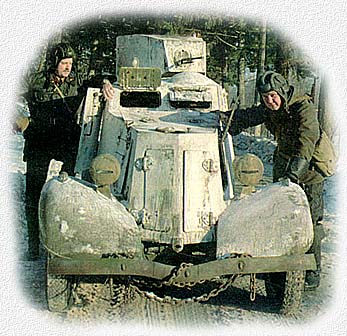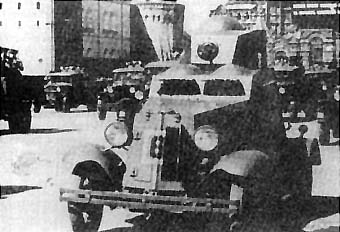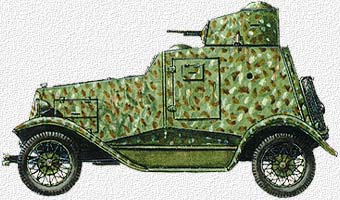| The FAI Light Armored Car |
|---|
|
|

The FAI-M armored car. The last alive vehicle.
| The FAI Light Armored Car |
|---|
|
|

| Note: All Russian terms and abbreviations shown as red italic are described in the Glossary. |
Manufacturing of the FAI, one of the most mass-produced armored cars in Soviet history, began with a contract between the Soviet Government and Henry Ford's corporation. On May 31, 1929, according to that contract, Ford was to supply the plans for the "Ford-A", "Ford-AA" and "Ford-Timken" trucks.
 The FAIs on the military parade in Moscow. |
In February 1930, truck assembly began at the "Gudok Oktyabrya" factory in Nizhnij Novgorod. In November 1930, the "KIM" factory (Moscow) commenced truck production as well. From April 1932, manufacturing of the "Ford-AA" trucks also began at a new factory located in Nizhnij Novgorod. This factory was built by the Ford corporation under contract. Here, from December 6, 1932, the manufacturing of the "Ford-A" truck had begun.
Later, Nizhnij Novgorod was renamed to Gorkiy, and its factory was renamed to "GAZ imeni Molotova" (Molotov's GAZ). The specifications for all vehicles were re-calculated from the British (inch) to the metric system. After that all vehicles received new names:
| "Ford-A" | - "GAZ-A" |
| "Ford-AA" | - "GAZ-AA" |
| "Ford-AAA" | - "GAZ-AAA" |
Soon after the contract with Ford was signed, the Russians made several attempts to develop a light armored car on the "Ford-A" chassis (this confirmed by the order of UMMA RKKA). The design bureau (Chief engineer N.I.Dyrenkov) developed two armored cars: the D-8 and the D-12.
 The FAI armored car. Spain. 1938 |
In 1931, both vehicles were accepted for service, although they didn't satisfy all the Red Army's demands. This was mostly because the design?s non-traversing machine-gun installations left the sides and rear unprotected. As a result, designers were ordered to develop a new hull with a new turret with 360° traversing. |
In 1931-1932, by the order of UMMA RKKA, the design bureau of the Izhorskiy Factory developed a new vehicle. The new armored car was named "Ford-A Izhorskiy" or simply FAI. Mass production of the FAI started in 1933.
 The FAI armored car. Spain. 1938 |
The main armament of the FAI was a single DT machine-gun, mounted in a revolving turret. The turret could be rotated manually, but in addition the MG's spherical mount allowed a ±10° horizontal angle of fire without traversing the turret. In 1935, some vehicles received special steel tyres instead of the conventional rubber tyres. These steel tyres allowed the FAI variant to run on railroad tracks with an 86 km/h top speed. |
Such vehicles (some sources name them FAI-J) were used as armored rail scout cars in connection with armored trains. However, they could only reverse at 24 km/h - which made them too slow to be completely practical as rail vehicles.
In 1935, at the Izhorskiy Factory a new armored car was developed, based on the chassis of the M-1 automobile. This new vehicle had more room for the crew, some of whom would be equipped with radio.
With the advancements allowed by the M-1 chassis, mass production was shifted from the FAI to the new armored car--named the BA-20. However, after the production change, about 300 FAI's hulls still remained in factory warehouses. So, the Soviet engineers came up with an idea to mount these hulls on the M-1 chassis. This "hybrid" was classified as the FAI-M. Prior the Great Patriotic War, FAIs were the most widespread armored cars in the Red Army. They took part in all military conflicts from 1930 to 1943. Moreover, they served in Spain during the Civil War, where both sides used those vehicles widely. Until recently, most people believed that only one FAI hull remained, the damaged example now housed in the Warsaw (Poland) military museum. However, another FAI-M in running condition appeared at the "Exotic vehicles-98" exhibition on July 10-12, 1998, at Tushino, Moscow. It was displayed by the "Club of the Military History of RKKA". The remains of this vehicle were found and recovered from a swamp near Novgorod. |
| Parameter | FAI | FAI-M |
|---|---|---|
| Crew, men | 2 | 2 |
| Armor, mm | 6-4 | 6-4 |
| Armament | 1 x 7.62 mm TD TMG | 1 x 7.62 mm TD TMG |
| Ammo | 1323 rounds | 1323 rounds |
| Engine | "GAZ-A" 4-cylinder petrol, 42 h.p. | "GAZ-M1" 4-cylinder petrol, 50 h.p. |
| Fuel, litres | 40 | 60 |
| Range, km | 200 | 315 |
| Max. speed, km/h | 80 | 90 |
Sources:
"The armored cars", NIIBT Poligon GBTU KA, Kubinka, 1944 "World War II", Quadrillion Publishing Ltd. "Tankomaster", #2, 1996 "Bronekollektsiya", #1, 1998 |